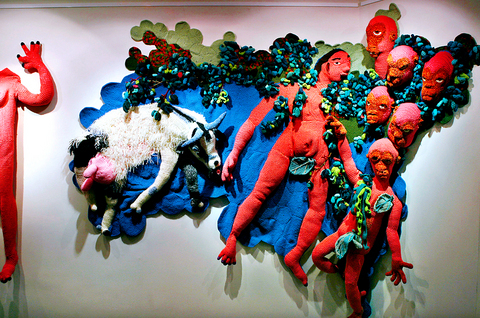"Public Art Private Parts" has returned to Washington -- only this time, the exhibit of completely crocheted pieces is drawing stares, giggles and even buyers instead of complaints.
Taiwan-born artist Ming Yi Sung Zaleski's nude figures created an uproar in 2005 when they were shown in the lobby of a downtown office building. She was asked to remove her work from the lobby show, "Not the Knitting You Know," following complaints.
Zaleski's naked human and animal figures are now on display at the Nevin Kelly Gallery, along with a whimsical, five-minute film that explains why fig leaves cover the anatomically correct crocheted private parts. Those who are not offended are invited to lift the leaves.

PHOTO: AP
Brandon Bloch, a first-year graduate student at American University, created the film about how Zaleski responded to complaints from a law firm tenant of the downtown Washington building where her work was on view in 2005. Bloch used interviews with Zaleski, gallery owner Nevin Kelly and the knitting exhibit's curator, Binnie Fry, along with animated figures representing Zaleski's art.
The film also features animated caricatures of aghast art patrons.
"I was saving myself for my wedding night," a crying matron wails after seeing crocheted genitalia. A mustached gentleman with a cane and top hat wonders, "What manner of beast created such indecency?"
In response to the law firm's requests to remove her art, Zaleski added the fig leaves to the offending private parts.
"It never crossed my mind to have my work censored," said Zaleski, a 33-year-old art teacher. "I figured this is a grown-up working place and if people are bothered by it, I'll cover it up, and if people want to see what's underneath, they can look."
Each figure took her about two weeks to crochet, and her work includes male and female private parts of monkeys, humans and a goat. She also includes hermaphroditic figures.
"I'm not really a very political person," Zaleski said. "I just wanted to do my artwork, and I am still very interested in human figures. I don't like making sweaters when I crochet."
The artist said she has moved on from the controversy, which she finds amusing.
She noted that people who complained -- mostly men -- kept their eyes on the art.
"Even though their feet were walking, their heads kept turning and looking in this direction," she said. "If it bothers them so much, why do they keep looking?"
Julia Morelli, deputy director at the Nevin Kelly Gallery, said the new exhibit has been well received, with no complaints -- not even from the church next door. Three of nine available pieces have been sold.

Former Nicaraguan president Violeta Chamorro, who brought peace to Nicaragua after years of war and was the first woman elected president in the Americas, died on Saturday at the age of 95, her family said. Chamorro, who ruled the poor Central American country from 1990 to 1997, “died in peace, surrounded by the affection and love of her children,” said a statement issued by her four children. As president, Chamorro ended a civil war that had raged for much of the 1980s as US-backed rebels known as the “Contras” fought the leftist Sandinista government. That conflict made Nicaragua one of

COMPETITION: The US and Russia make up about 90 percent of the world stockpile and are adding new versions, while China’s nuclear force is steadily rising, SIPRI said Most of the world’s nuclear-armed states continued to modernize their arsenals last year, setting the stage for a new nuclear arms race, the Stockholm International Peace Research Institute (SIPRI) said yesterday. Nuclear powers including the US and Russia — which account for about 90 percent of the world’s stockpile — had spent time last year “upgrading existing weapons and adding newer versions,” researchers said. Since the end of the Cold War, old warheads have generally been dismantled quicker than new ones have been deployed, resulting in a decrease in the overall number of warheads. However, SIPRI said that the trend was likely

BOMBARDMENT: Moscow sent more than 440 drones and 32 missiles, Volodymyr Zelenskiy said, in ‘one of the most terrifying strikes’ on the capital in recent months A nighttime Russian missile and drone bombardment of Ukraine killed at least 15 people and injured 116 while they slept in their homes, local officials said yesterday, with the main barrage centering on the capital, Kyiv. Kyiv City Military Administration head Tymur Tkachenko said 14 people were killed and 99 were injured as explosions echoed across the city for hours during the night. The bombardment demolished a nine-story residential building, destroying dozens of apartments. Emergency workers were at the scene to rescue people from under the rubble. Russia flung more than 440 drones and 32 missiles at Ukraine, Ukrainian President Volodymyr Zelenskiy

Indonesia’s Mount Lewotobi Laki-Laki yesterday erupted again with giant ash and smoke plumes after forcing evacuations of villages and flight cancelations, including to and from the resort island of Bali. Several eruptions sent ash up to 5km into the sky on Tuesday evening to yesterday afternoon. An eruption on Tuesday afternoon sent thick, gray clouds 10km into the sky that expanded into a mushroom-shaped ash cloud visible as much as 150km kilometers away. The eruption alert was raised on Tuesday to the highest level and the danger zone where people are recommended to leave was expanded to 8km from the crater. Officers also